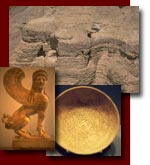| Site Map | Contacts | Links | Newsletter | |
Biblical Archaeology:
Date of Genesis
The book of Genesis seems to be a mixture of early and late material with much editing or redacting.
Genesis chapter one is very different from Genesis chapter two. In chapter one the word used for God is Elohim, while in chapter two Yahweh is used alone or with Elohim. Genesis two seems older than chapter one. I believe Genesis one was added on later with Elohim added to Yahweh in chapter two. It seems that two different stories of creation were added together and then edited to smooth out the story.
| Late Material or Editing in Genesis | Rebuttal of Evidence |
|---|---|
| Genesis 11:28 "Ur of Chaldeans." Chaldeans did not come into use until the Neo-Babylonian period, 6th century BC | This is a later scribal addition |
| Genesis 14:14 the city of Dan is mentioned. This city was called Laish until the time of the Judges when the tribe of Dan took the city (Judges 18:29). | This is a later scribal addition |
| Genesis 36:31 "And these are the kings that reigned in the land of Edom, before there reigned any king over the children of Israel" (KJV) This was written when there were kings in Israel. | This is a later scribal addition |
| Genesis 10 The Table of Nations: many cities named did not exist at the time of Abraham. Verse 2 "Magog" first appears in Late Assyrian Texts. Verse 11 Nineveh is not known until it was made the capitol of the Assyrian Empire by Sennacherib. Before this was Calah. Verse 14 the Philistines are mentioned who did not come to Canaan until 1200 BC. | This is a later scribal addition |
| Genesis 21:32,34 "Land of the Philistines" Abraham makes a treaty with the Philistines who did not come to Canaan until 1200 BC. | This is a later scribal addition, or there were small number of Philistines who came earlier, but there is no evidence of this. |
| Genesis 21: 22 "Beersheba" This city did not exist until Iron Age I (1200-1000 BC). | They were not digging in the right place, but there is no other site for Beersheba. |
| Genesis 1-11 has many similarities between ancient Babylonian and Sumerian stories of creation, fall, flood, and tower of Babel. This was learned during the Babylonian captivity. | The Gilgamesh Epic was found at Megiddo 10th century BC. |
| The calendar being used does not mention the pre-exilic months nor the Babylonian months learned during captivity and used after their return from exile. | The text was updated. |
| The Hebrew is standard Hebrew not Paleo-Hebrew. | The text was updated. |
| Genesis 14 The kings mentioned here have never been found. | They might be found. The name fit better in the Iron Age. |
| Genesis 47:11 "Rameses" is mentioned. Rameses was not Pharaoh until the 13th century BC. | This is a later scribal update. |
| Genesis 37:25 Camel Caravans. Wide use of camels was not until the 8th century BC. First mention is in the reign of Shalmanseser III. Late 9th century | |
| Genesis 37:25 Ishmaelites are only mentioned in books of late recension (Redford, 1970, 194) Late 8th century | |
| Genesis 37:25 "spicery and balm and myrrh" 7th century trade. | |
| Genesis 37:28 "20 pieces of silver" Slave trade from the end of the 8th century. Kitchen says 18th century. | |
| Genesis 40:15 "Land of the Hebrews" This phrase is used in the Saite and early Persian periods. | |
| Genesis 41:8 "Magicians of Egypt" This term is not used until the middle of the first millennium BC. | |
| Genesis 37:9 Joseph's Dream and the zodiac. First mention of the zodiac is 419 BC (Redford, 1970, 204). | |
| Genesis 41:1-8 Pharaoh's Dream of Cows. Cow symbolic of a year is common in Ptolemaic times and not earlier. |
